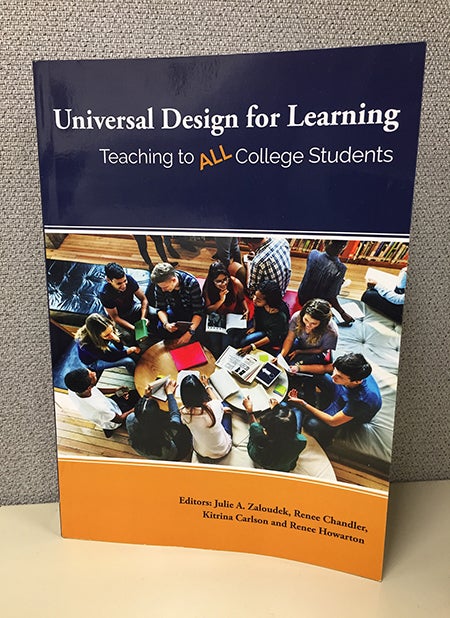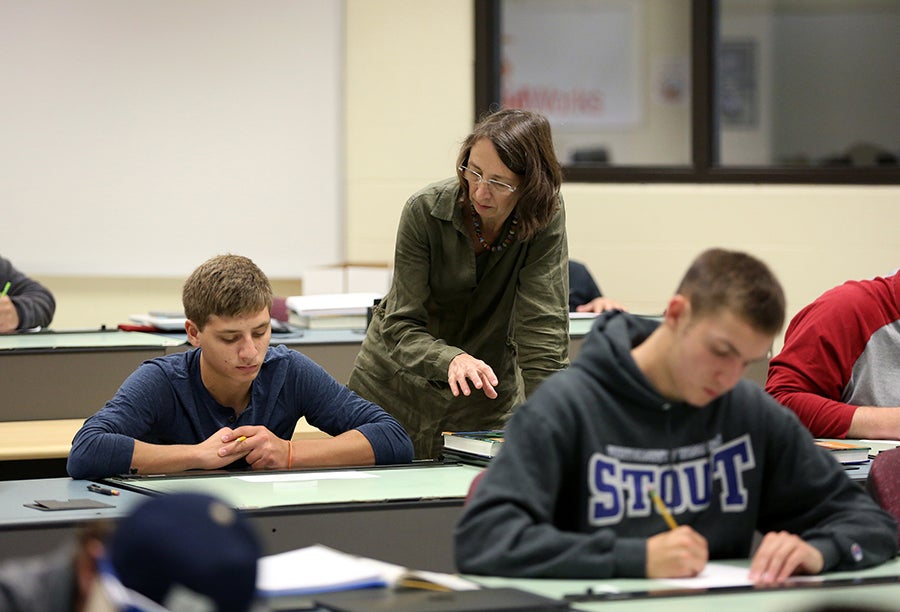A book dedicated to teaching diverse populations of students written by eight current or former faculty members has become the first book published by the Nakatani Teaching and Learning Center at University of Wisconsin-Stout.
“Universal Design for Learning: Teaching to All College Students,” was published late last year.
Editors and writers include:
- Renee Chandler, director of UW-Stout Graduate School and Stout Online
- Renee Howarton, Nakatani Teaching and Learning Center director
- Former faculty members Julie Zaloudek and Kitrina Carlson
Other writers include:
- Monika Herrmann, assistant professor, engineering and technology
- Diane Olson, professor, operations and management
- Glendali Rodriguez, professor and associate provost
- Debbie Stanislawski, professor, teaching, learning and leadership
 Universal Design for Learning research projects were conducted across diverse majors by instructors at UW-Stout from 2011 to 2013. Each chapter contains a personalized introductory story, an analysis of the learning needs of their students, what faculty did to meet those needs, the specifics of the project developed and reflections on lessons learned.
Universal Design for Learning research projects were conducted across diverse majors by instructors at UW-Stout from 2011 to 2013. Each chapter contains a personalized introductory story, an analysis of the learning needs of their students, what faculty did to meet those needs, the specifics of the project developed and reflections on lessons learned.
“UDL is a very timely topic,” Howarton said. “It looks at every way possible to expand learning to the broadest range of students. Through this research, we were all learning together.”
When the educators started incorporating UDL practices into their classes, they were not planning on writing a book. However, after reflecting on their experiences and research and knowing that there was limited UDL scholarship at the college level, they wanted to share them.
“My primary interest was helping my students to be successful,” Chandler said. “This was a model that really helped students to be successful.”
The book tells the story from the perspective of the instructors and gives information on how students reacted to the course design, Chandler said.
To make the chapters cohesive, the writers included information on their analysis, design, development, implementation and evaluation of UDL in their classes. They shared what worked and what didn’t, Howarton said. Each chapter is a work of its own.
The book also describes the history of Universal Design for Learning and recent research pertaining to its instructional training.
“UDL is an intentional process that involves thinking about and how to make learning accessible to all students,” Chandler said. “Our hope is UDL will become more common in college classrooms and institutions will be more understanding of the diversity of the students they are teaching and their needs.”

Rodriguez said the book fits with UW-Stout’s cross-disciplinary polytechnic approach by looking at course content from a variety of perspectives. “UDL helped me feel more confident about the importance of presenting diverse information in diverse ways,” she said. “That’s actually really important.”
Rodriguez implemented UDL in a course she was teaching in 2012 called the Built Environment, which focused on construction and its relationship to resources, materials and the culture in which it takes place. The UDL approach focuses on representing information in multiple formats and media, providing multiple pathways for students’ action and expression and multiple ways to engage students’ interest and motivation.
“At first I was skeptical about going through extra steps to provide choices for the students since the ‘real world’ may not be so accommodating,” Rodriguez wrote. “My goal was to prepare students for their next professional experience, and I did not want to compromise this. However, through this journey I learned that students who are passionate about learning, regardless of their style, benefit from choices for engagement and expression because it stimulates their own investment in the content and is deliverable.”
In the book, Chandler wrote that “the need for research-based approaches that meet diverse student needs spurred the authors of this book to dig deeper. We engaged in classroom-level investigations that inspired us to look at our own teaching differently. We grappled with issues of fairness, social justice and equity as we made decisions about how to design our courses. It has been (and continues to be) a developmental process.”
The book is really about reaching all learners, Chandler said. “Students express learning in a variety of ways. Choice is very, very important.”
The intent wasn't to have all women writers for the book, but those were the ones who chose to continue with the intensive, ever-changing writing project, Howarton said.
The book, available at Amazon.com, would not have been possible without funding from UW-Stout Online and the Nakatani Teaching and Learning Center that helped faculty experiment with applying UDL principles within the classroom. The book also received support from administrators and staff.
The Nakatani Teaching and Learning Center is devoted to promoting and supporting the art and science of teaching. The center encourages valuing teaching and learning by all members of the UW-Stout community, through collaboration, creating programs for faculty development and facilitating the use of technology.
The Nakatani Endowment, which funds the center’s programs, was established in 1993 through a bequest from Kiyo Nakatani, in memory of her late son, Arthur M. Nakatani, a UW-Stout alumnus who earned his bachelor’s and master’s degrees from UW-Stout in 1971 and 1972 respectively and taught elementary school in Hawaii until his death in 1989. In 2008, the Teaching and Learning Center at UW-Stout was renamed the Nakatani Teaching and Learning Center.
###
Photos
The cover of “Universal Design for Learning: Teaching to All College Students.”
Monika Herrmann, one of the book authors, works with students in her Engineering Graphics Fundamentals class.





